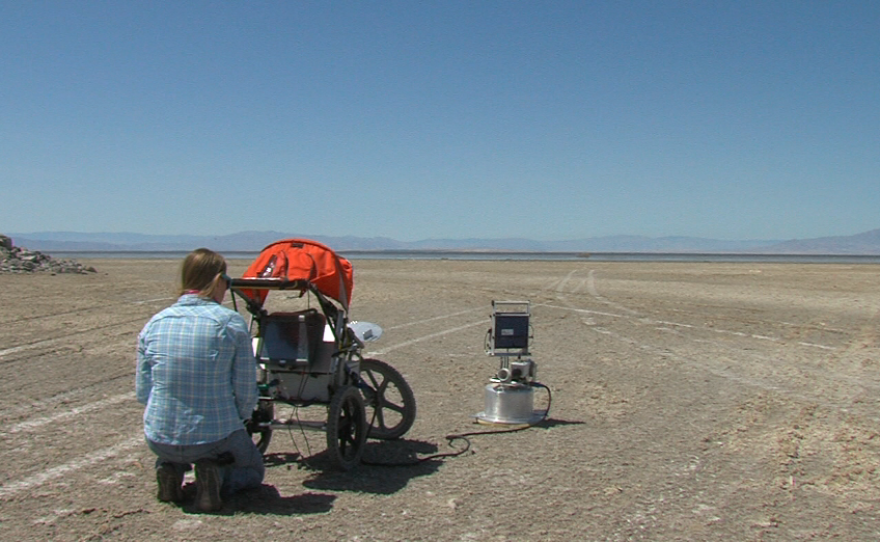Jessica Lovecchio's job with the Imperial Irrigation District requires her to push a baby carriage all around the Salton Sea.
Her carriage holds a cylindrical machine called a Piswerl. Placed on the desert floor, it creates a windstorm in a bottle to measure emissions of wind-borne dust.
Lovecchio takes her first measurement far from the water's edge, then walks toward the shoreline to map emissiveness in parts of the playa that were underwater not so long ago. It's a walk that's been getting longer lately.
"This area, when we first started doing Piswerl emissions, the sea wasn't that far," she said, pushing the carriage toward the banks of Red Hill Bay. "We probably stopped about here," she said, still many yards from the water.
Even as it shrinks, the Salton Sea is still California's largest lake. It was created in 1905 when a Colorado River diversion project breached. Now nearby farms replenish it with agricultural run-off (and pesticides, which have been accumulating on the lakebed for decades).
As farmers have fallowed their fields to sell the saved water to San Diego County and Coachella Valley, a decreased amount of water has been going in the Salton Sea. Under a water deal approved in 2003, IID has been putting water directly in the sea to slow the receding shoreline. This will end in 2017 and is expected to speed up the shrinkage of the sea. The water deal is the largest farm-to-city water transfer in U.S. history, and it was signed under one major condition.
"The state of California said in the water transfer agreement that they would restore the Salton Sea," Lovecchio said. "To date we haven't seen any progress with that."
That lack of action is part of the reason she's out here now, she said. "We're looking at areas to see what is emissive right now, what we can do about it."
The IID plans to pursue restoration projects of its own. They want to re-flood parts of Red Hill Bay, creating habitats for migratory birds that rely on the sea. In theory, those habitats — along with new geothermal energy plants planned for this area — will keep down the dust.
"We're really pushing for a smaller, but sustainable Salton Sea," Lovecchio said. "We still want the Salton Sea here, we just want one that is manageable."
For much of the year, the Salton Sea air basin exceeds California air quality standards for wind-borne dust. No one around here wants a sequel to Owens Lake, which had its water siphoned off by its southern neighbor Los Angeles in the early 20th century. It went on to become the largest source of dust pollution in the entire country.
Air quality monitors at Owens Lake also use Piswerls to keep track of dust, Lovecchio said. "We have almost the same teams down here. They know about Owens Lake. They're here, helping us do on the ground analysis now before we have an issue like Owens Lake."
Meanwhile, people who live right next to the Salton Sea worry about its future.
Yalimar Perez lives on the opposite side of Red Hill Bay, in North Shore, just blocks from the water.
"It has like this really nasty reputation that you're going to go inside and you're going to come out without an arm, or without an eye or something," she said.
At the beach, waves lap against dead fish that can't tolerate water saltier than the ocean. Walking on the sand feels strange because the sand is actually ground-up fish bones.
Perez learned about the Salton Sea and how it's changing through the Green Academy, an environmental program at her high school.
"My teacher, he would talk about the Salton Sea," she said. "And I was like, well, I live so close, why haven't I gone?"
When she did finally go, she was surprised to find it was actually pretty nice.
"It's dirty from the inside, maybe," she said. "But from the outside it's beautiful and there are still birds here. The birds are still alive."
But Perez has learned that the Salton Sea is not in great shape. And she knows that lots of people here have asthma which could be aggravated by a drying sea.
Neighboring Imperial County leads the state in childhood asthma hospitalizations.
Maria Gudiño also lives in North Shore, but she doesn't like to get too close to the Salton Sea. She said it can trigger her asthma attacks.
"I almost never go," she said. "But when I have gone, I have to cover my nose."
Three of Gudiño's children also have asthma.
Even if the Salton Sea were pristine, winds would still carry dust from other parts of the desert. And pollution from industry, shoddy housing, and vehicles idling at the border are also major concerns.
Whatever's driving these breathing problems, Perez said in a community where many don't speak English, people feel out of the loop.
"The wind is going to pass by, and it's going to go into our lungs," she said. "It's going to go into our bodies, into our systems, and that's not going to be good for us. People with asthmas are going to get more attacks. We could get a lot of sicknesses out here."
Preventing dust issues would be expensive. But according to one recent study, not fixing the Salton Sea could create a nearly $30 billion problem. Worsening public health would be part of that burden.






